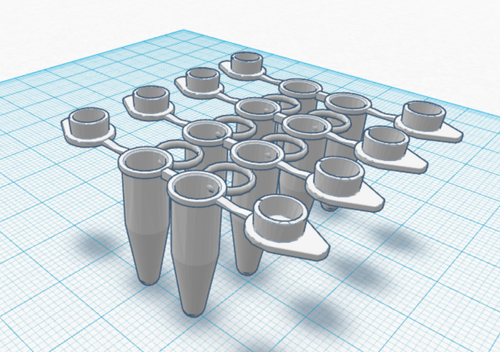BME100 f2013:W1200 Group12 L6
| Home People Lab Write-Up 1 | Lab Write-Up 2 | Lab Write-Up 3 Lab Write-Up 4 | Lab Write-Up 5 | Lab Write-Up 6 Course Logistics For Instructors Photos Wiki Editing Help | ||||||
ChamberS
LAB 6 WRITE-UPComputer-Aided DesignTinkerCAD TinkerCAD is an online tool which allows the user to create and edit existing 3D computer generated objects. In class, we used TinkerCAD to edit PCR tubes. The edits we made were connecting tubes with circles and rows together with lines. The circles are there to allow the tubes to be stacked on top of one another. They are connected by rows, but can be broken apart easily for use in a PCR machine.
As scientists and engineers, we strive to create the best of the best and then improve it. TinkerCAD allows people to take an existing design and make it better. Everyone thinks differently, and when the best and most innovative ideas from different people are applied to a single design, then the result is one of the best product possible. Someone may even take the design we made and make it better in the future.
Feature 1: Cancer SNP-Specific PrimersBackground on the cancer-associated mutation Rs17879961 is an organic molecule, which is a polymorphism expressed in Homo sapiens. Rs177879961 is a single nucleotide polymorphism or SNP, and is known to affect the 22nd chromosome, and is pathogenic in origin. Chromosome 22 is important in the coding and synthesis of many proteins, containing about 500 to 600 genes that are in the body. In chromosome 22 rs17879961 takes affect on checkpoint kinase 2, or CHEK2 for short, which is key in preventing the development of cancerous tumors. Specifically, CHEK 2 inhibits CDC25C phosphatase which acts as a tumor suppressing protein. By altering the coding of the chromosome, rs17879961 leads to a number of disorders concerning the genes in chromosome 22.
Primer design
How the primers work: The primers work by finding or recognizing a "target sequence," which is where the cancer SNP rs17879961. This specific cancer reverse primer will aid in the locating of the corresponding target sequence binding it together with the cancer SNP. In order to function properly matching target sequences must be bound together. Normally, the sequence for a non-cancerous individual would be ATT, but the SNP transforms the sequence cancerous, reading ACT. The forward primer must find a complementary sequence in order to bind properly. If the primers are not matched 100% then it will be impossible for the PCR reactions to run, and there will be no amplification. Depending on the template strand, the the results will come out matching the original sample regardless of whether or not it truly is cancerous or not,
Feature 2: Consumables KitOur kit will come in a plastic box with a lid that will lock in place. We have incorporated a special design with the PCR tubes to save space in the box. This design makes it possible for the PCR tubes to be stacked on top of each other. Also, there will be black plastic PCR tubes so no light can bleach the green dye. The PCR machine itself will come partially assembled to avoid confusion when putting the device together (unlike IKEA products). Also included will be a flourimiter, glass plates along with an adjustable stand to hold all types of phones. One of the major problems our packaging will be addressing is the bleaching of the green dye. If the green dye is exposed to light for too long, then it will become useless. The black tubes will allow no light to pass through.
Feature 3: PCR Machine HardwareOur groups new and improved open PCR machine will be used for the same reasons as it was used before, but it is now much more efficient. Through the use of blue tooth technology, the data from the open PCR will be transferred to a computer much quicker. The data can now be analyzed much earlier than it was before because that data will be inserted on the computer simultaneously as the experiment is being carried out. A notification can also be sent to the users smart phone when the open PCR is done. This is much more convenient for the consumer because they will know exactly when all of the open PCR machine's phases have been carried out. In conclusion, our improvements to the Open PCR machine have made it a much more efficient and convenient process.
Feature 4: Fluorimeter HardwareThe fluorimeter will be used in the same way that it was used previously. It will be used to detect the desired DNA and can still be used to detect if somebody has a certain mutation. The main difference is that it will be must more efficient, accurate, and have a much higher convenience level. Having to take a photo with a cellular phone, and then send it to the computer through email was a very high inconvenience and was very time consuming. Now that our new and improved fluorimeter uploads the pictures automatically through the use of bluetooth, the inconvenience will be taken away and the process will be sped up greatly.
Bonus Opportunity: What Bayesian Stats Imply About The BME100 Diagnostic ApproachIn calculation 3 the question is asking for the probability that the patient will develop cancer, given a cancer DNA sequence. The results for calculations 3 and 4 imply that the method of CHEK2 PCR for predicting cancer is not very sensitive, but is somewhat specific. This is because the numerical results for calculation three were very small, and all the results ended up being less than one. In calculation 3 the question is asking for the probability that the patient will develop cancer, given a cancer DNA sequence. Calculation 3 describes the specificity of the system regarding the ability to detect the cancer in the SNP. Since P(AIB) is less than 50 % it has very little specificity. Calculation 4 asks what the probability that the patient will not develp cancer, given a non-cancer DNA sequence? The calculation of 4 describes the specificity of the system regarding the ability to predict cancer. Since P(AIB) is less than one it is not very accurate and has very little specificity. Since the calculations of 3 and 4 or not as accurate as they should be there is probably either human error or error from the PCR machine. The PCR machine would not be very reliable in detecting cancer, and another form of detection should be used as well. |
||||||






